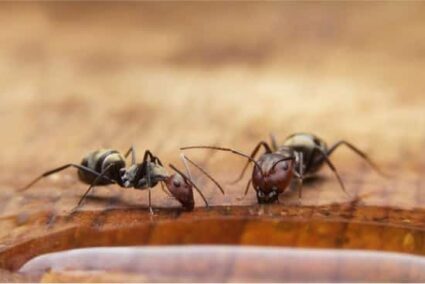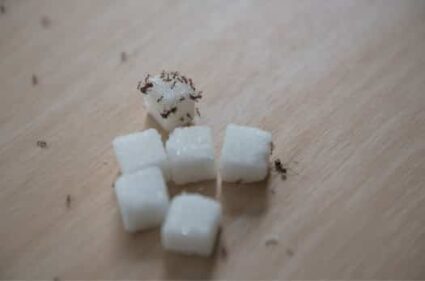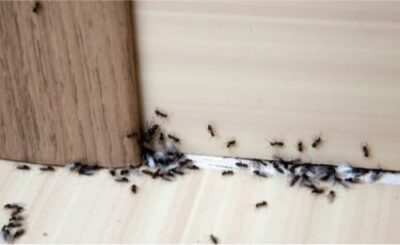Bed bug treatments are costly and don’t always work. But natural bed bug treatments, such as using ants to kill bed bugs, are often overlooked. But using a pest to kill a pest isn’t recommended.
Ants scavenge and can eat their dead bodies. However, they usually don’t hunt bed bugs as they hide in places that aren’t easily accessed. The ants can’t find them to eat them, let alone kill them. Different species, like red imported fire ants, are a natural predator of bed bugs, but don’t kill them frequently.
Even if ants kill bed bugs, that doesn’t mean you should let them. You should kill your bed bug infestation with heat, not ants. Ants are a terrible natural bed bug treatment, as we’ll explain.
Do Ants Eat Bed Bugs?
The idea that ants kill bed bugs has a long history. According to Gothamist, a newspaper article from the Salt Lake Tribune in 1907 covered the topic. Supposedly, a crew of train workers would keep a lizard with them while they took a break.
The lizard would eat any flies or other insects that would otherwise disturb them. But better yet was their solution for bed bugs. The workers would let loose a jar of black ants to kill them. Their train carriages were infested with bed bugs after hobos had stayed there.
The article did state that the solution worked: “The ants seek out and destroy the bed bugs industriously.” Even since then, the idea that ants kill bed bugs has occasionally resurfaced. Whether it’s true or not is another question.
As for why somebody would make up a story like this, that’s unclear. Many stories from this era weren’t fact-checked. They were repeated from other newspapers across the story, or made up to fill space. As such, don’t take it at face value.
Do Ants Eat Other Insects Like Bed Bugs?
The first thing to specify is which ant species are most common in the U.S. North America—so, Mexico and Canada included—is home to almost 1,000 recognized ant species. The species and its behavior vary according to their habitat.
There isn’t an ant species that’s the most common in the U.S. However, one thing that is true of most ants is that they eat sugary substances. They have that reputation for a reason.
The most common source of food is either rotting fruit, or nectar. The primary food of most ants is honeydew. This is, essentially, the waste product that aphids leave behind. Aphids feed on sap and produce a sticky, sugary substance as poo.
Many ant species farm aphids by collecting them and protecting them from harm. They continually feed on this honeydew and take it back to their colony.
However, ants may also eat leftovers. Some ants do eat insects such as bed bugs, although how common that is, is up for debate. But many ant species eat dead insects, at least.

Different Ant Species that Kill Bed Bugs
When you look down and see an ant, one never looks too different from another. Some may be bigger, and some smaller. Some may be black, and some may be red. But with 1000 different species, they vary more than we realize.
They especially vary in behavior. While some ants eat certain things, others don’t. And some will kill for their food, but the vast majority won’t—instead, they’ll scavenge. This is one of the main reasons why ants aren’t an effective bed bug treatment option.
Let’s take a look at some of the most aggressive ant species and see whether they eat bed bugs.
Carpenter Ants vs. Bed Bugs
Carpenter ants are one of the most common species in the United States. They are large ants, at around an inch at their biggest. They’re black, and infest homes where food is available.
Most people think they eat wood—hence their name. And if you find them in your home, you’ll likely see them crawling in and out of holes in wood. However, they don’t eat wood. They excavate it to live and lay their eggs in.
Carpenter ants eat a wide variety of foods. They usually eat leftovers, but they are considered both predators and scavengers. They forage at night for dead insects, both in the wild and in homes. They surround it and extract its fluids, leaving the rest of the insect intact.
This means that carpenter ants don’t kill bed bugs, but they can feed on them. They have a sting but only use it rarely, when disturbed.
Argentine Ants vs. Bed Bugs
The Argentine ant is native to South America—Argentina, Uruguay, Brazil, and several other countries. But in recent years, trade has inadvertently helped this ant travel around the globe.
These are small ants, at no more than 1/10 of an inch long, although queens are longer. They’re dark brown to black color. Like carpenter ants, they can live in cracks in walls, not just wood. They don’t build deep nests like other species, but rely on the environment as they find it.
Argentine ants are good at colonizing new areas. That’s because colonies don’t attack one another over resources. Instead, they work together. They have so far successfully colonized the south, around Louisiana and Mississippi, as well as the West Coast.
Like other ants, they feed on a variety of things. Argentine ants prefer sweet foods, but will eat dead insects for their protein content.
But, again, they won’t kill bed bugs that they encounter. They don’t have stingers like other ants, so they can’t easily kill bugs anyway.
Red Imported Fire Ants vs. Bed Bugs
Red imported fire ants, or fire ants for short, are originally from South America too. And like Argentine ants, they have made their way around the world: Australia, New Zealand, Asian countries, and the U.S. all included.
They are perhaps the worst type of ant you could have colonizing your home. They get their name from their venom, which causes an intense burning sensation. The area they bite swells up, not unlike a bed bug bite. For some people, they even cause anaphylaxis.
Fire ants are omnivores, but they usually scavenge instead of predating. They can feed on dead mammals and insects. Like many other ant species, they feed on honeydew droplets created by aphids.
However, RIFAs are known as voracious predators of insects where they get the chance. They will gang up on an insect, kill it, and take it back to their colony. Or, they might drain the bug dry where it died without carrying it back home.
But it’s more likely that these ants wouldn’t hunt bed bugs. They would scavenge on one if they found it dead. As we’ll see, there are good reasons why hunting bed bugs is too tricky for them.
European Fire Ant vs. Bed Bugs
The European fire ant is another invasive red ant species. But instead of originally being from South America, these ants are from Europe. They have a sting and are aggressive, if not quite as aggressive as RIFAs.
These ants are an invasive species in the eastern United States, especially the northeast around New York state, Massachusetts, Rhode Island, Vermont, New Hampshire, Maine, and Canada.
Again, these ants mainly feed on honeydew. However, they may attack and eat insects that they find. Even small bed bugs will provide them with much-needed protein and nutrition.
They will especially attack any creature that disturbs their nest, be that something they can eat, or something big like you.
These ants aren’t spread throughout the U.S. yet. So, if you think you have ants that are eating bed bugs, it’s probably not these.
Pharaoh Ants vs. Bed Bugs
Pharaoh ants are one of the world’s major nuisance pests. Their exact origins are unknown—they may have come from anywhere in the world. They survive best in tropical conditions, which may indicate where they come from.
Today, they infest every corner of the globe, from Europe to the Americas, Southeast Asia, and in between. They especially infest hospitals. They can live anywhere in the world that has a reasonable temperature indoors.
Pharaoh ants are small compared to the others on our list. They only reach 1/16 of an inch long. Again, these ants feed on a variety of foods. They often alternate between carbohydrate-rich and protein-rich foods.
They will eat leftovers, and especially anything sweet. But if they have too much of something sweet, they will alternate to a different kind of food. This helps them maintain a nutritional balance in their colony.
These ants aren’t known as effective hunters, unlike red imported fire ants. As such, they wouldn’t necessarily kill any bed bugs they find. But because they’re so widespread, they may get more of an opportunity to hunt than other species.
Asian Needle Ants vs. Bed Bugs
Asian needle ants are one of the most likely ant species that kill bed bugs. They only recently arrived in the U.S., and still haven’t spread across the entire mainland. You can still only find them in the far South, e.g., Alabama, Georgia, South Carolina, North Carolina, Tennessee, and Virginia.
These ants have a venomous sting. Their venom is potent enough that it causes a painful welt if they bite you. It can also cause anaphylactic shock if you’re unlucky.
They have this sting so that they can hunt. Their favorite food is termites. When one of these ants encounters one, it wraps it in a bear hug and sticks its stinger deep underneath their skin. It’s unclear whether this kills or paralyzes them.
Either way, the ants will then take it back to their nest and keep it for later. If the termite is only paralyzed, it will stay fresh for longer.
It isn’t clear whether Asian needle ants can do this with bed bugs. According to CABI, termites make up roughly 80% of the Asian needle ant’s diet. The rest is made up of arthropods and other invertebrates.
This could hypothetically include bed bugs. Asian needle ants are a strong candidate for the ant that eats the most bed bugs.

Is Using Ants to Kill Bed Bugs Possible?
Even if you found the perfect ant species that feed on bed bugs, you still shouldn’t use them as a control method. Here’s why.
1) Ants Are a Pest Too
Ants themselves are a pest like bed bugs. Bed bugs are admittedly more irritating than ants. Bed bugs feed on people, while ants don’t. However, ants also do things that bed bugs don’t, such as:
- Getting into your food
- Damaging the structure of your home (e.g., carpenter ants)
- Exacerbating structural damage in your home
- Crawling around during the daytime
- Crawling on you at any time of day
Therefore, if you use ants to kill bed bugs, you are replacing the problem with another problem. And ants aren’t easy to get rid of either. They live in hidden places like bed bugs, and can quickly re-establish their infestation when killed.
2) Ants Can’t Reach Bed Bugs
Bed bugs live in hidden places. They find locations where they won’t be disturbed and hide there. Only at night, when it’s time for them to feed, do they come out.
When ants are scavenging, they prefer to do so in areas they can move freely. That’s because they need to surround their food source, to either move it or drain it. This would be impossible in the tight cracks that bed bugs live in.
This applies to dead bed bugs, too. Bed bugs die wherever it is that they’ve lived. These are places like cracks in the wall, or hidden under your mattress. Before they die, they tend not to move around as much, so they die in place instead.
3) Ants Damage Your Home
Ants are similar to termites in that many species cause damage to the structure of your property. The best example is carpenter ants, which burrow into wood to create their nests. But that isn’t the only way that ants damage property.
Ants that don’t burrow usually hide in cracks in the walls. In doing so, they can make the crack wider. This applies to the gaps in baseboards, floorboards, and more, too. However, this damage takes longer to appear than if the ants actively burrow into them.
Some species are attracted to electronics. They hide inside and can short-circuit them. This can present a fire risk. Also, most species deal with waste by dragging it outside their colony, which can cause piles of refuse.
Ants may also be a symptom of damage to your home, as well as a sign. Ants prefer moist and dark places to live. A large infestation may be a sign of water damage somewhere in your home that you can’t see.
At least ants don’t transmit disease in the same way that many other bugs do.
4) Ants Are Costly to Kill
Like with bed bugs, you’ll need to hire an exterminator to ensure you get rid of the infestation. You can try DIY methods, but these are ineffective compared to a sprayed pesticide. They also take a long time to work.
As such, you’ll need to hire an exterminator. But exterminators don’t come cheap. They will cost you hundreds of dollars to hire. The exterminators who treat ants are the same as those who treat bed bugs, so it won’t cost you any less.
Admittedly, ants are easier to kill than bed bugs. You can get rid of them quicker than you can get rid of bed bugs. But on the other hand, ants can come back in from the outside soon after treatment.
5) Many Ant Species are Invasive
Most of the species listed above are invasive. Native U.S. species are mostly harmless, and won’t hunt for their food. But the invasive species will.
This means that if you wanted to use ants to control bed bugs, you would likely use an invasive species. That’s a bad idea because:
- Invasive species harm native wildlife
- Invasive species can quickly grow out of control, and so are even more costly to kill
So, overall, there’s no point considering introducing ants to control bed bugs. It won’t work, and before you know it, you’ll have two infestations you have to get rid of. Consider hiring a pest controller, or at least some DIY bed bug treatment methods instead.

